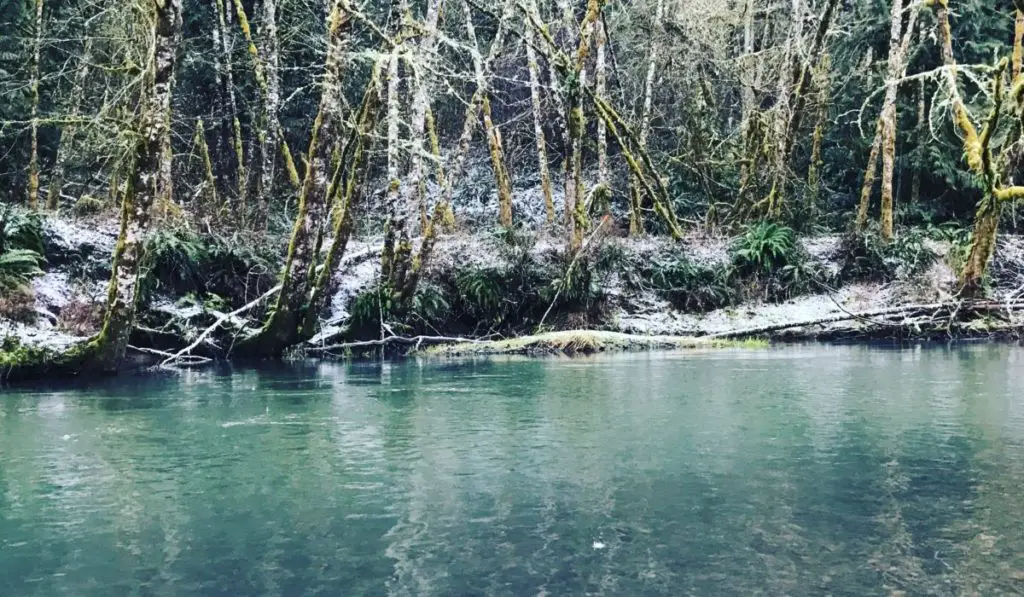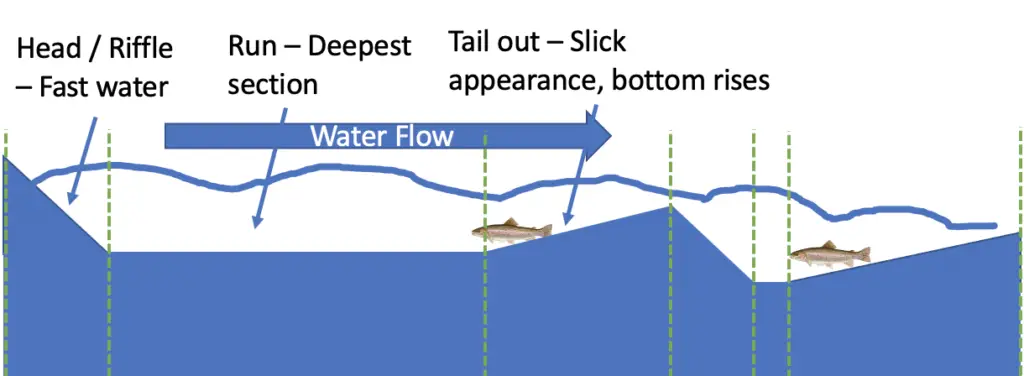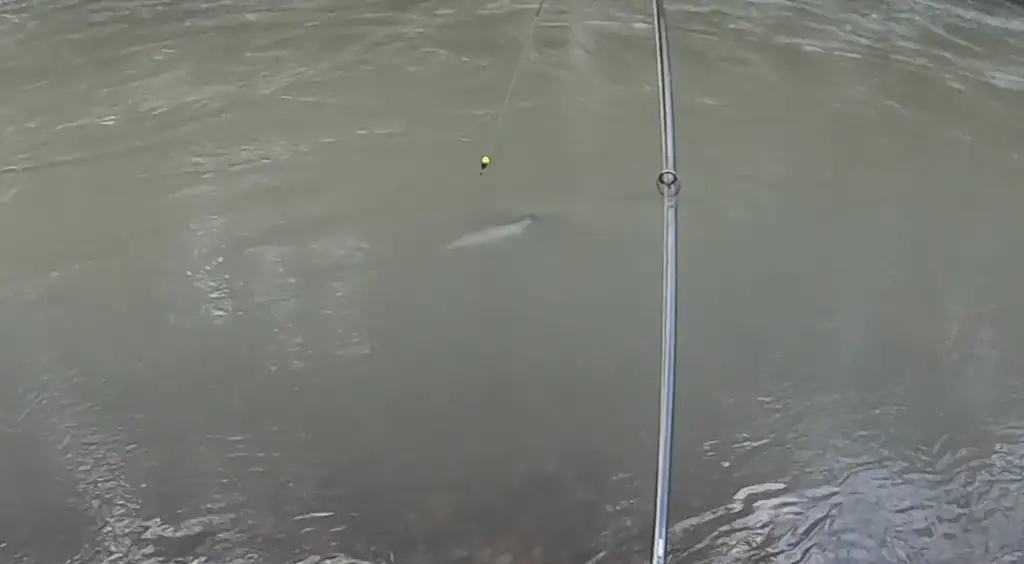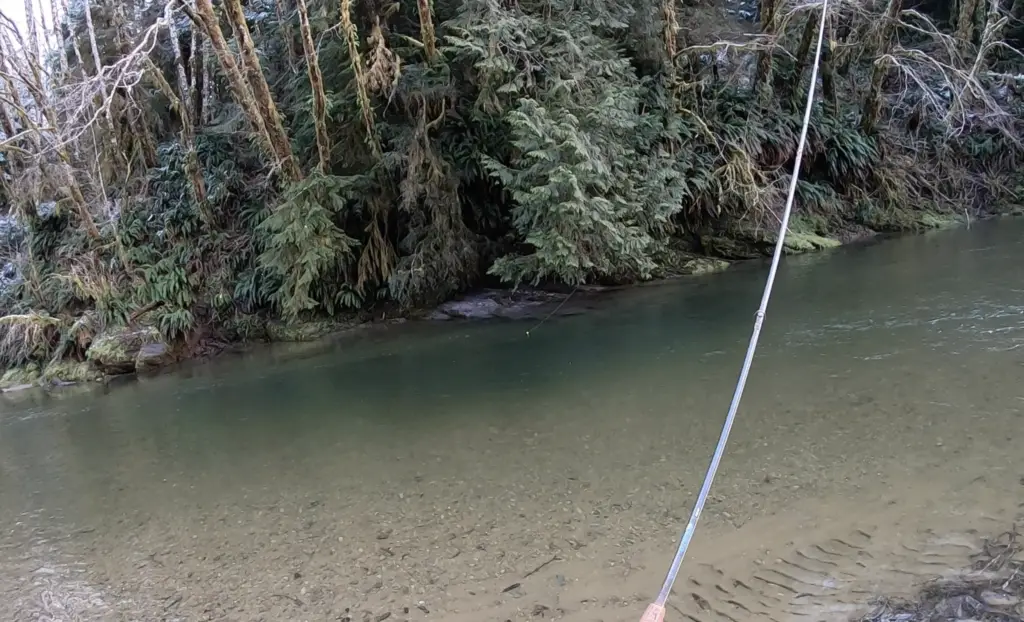
Finding steelhead is different than finding salmon in the rivers for a variety of reasons.
- There are generally fewer Steelhead.
- Steelhead do not always die after spawn (though they may), thus they prefer to save more energy in their upstream migration to spawn.
- Steelhead are genetically identical to rainbow trout, so any stream connected to saltwater with rainbow trout may also have some % which migrate to the salt and back (steelhead).
What do you once you’ve found the winter steelhead? You should head over to our grand reference to winter steelhead fishing for full details on rigging up, gear to use, and the bst steelhead techniques
Let’s dig into this topic and start with reading water to find winter steelhead.
Reading Water
First of all, as a disclaimer, steelhead can hold or travel through any water in the river in the right conditions. There are however general tendencies all steelhead will follow anywhere in the world in the most typical conditions.
And just because you find the perfect steelhead holding water, doesn’t mean there will be steelhead holding there. It’s about always playing the best odds.
What am I talking about? In a game of poker you may start with a great hand, but that doesn’t mean you will win every hand either. However, over time, you will win more often than not if you play the odds right.

Spending time fishing the water that winter steelhead prefer in whatever the river conditions are, will result in more steelhead to present your offering to.
Steelhead prefer walking speed water
You can find steelhead in a fast riffle, you can find steelhead in a soft edge of a current seam. However, most often, you will find steelhead in walking speed water. If you aren’t sure what I’m talking about, cast a float into the current, or throw a floating stick into the river and walk with it. Is it flowing faster, slower or the same speed as you’re walking? If it’s roughly the same speed, that’s walking speed water.
Winter Steelhead prefer to hold near a tail-out
Winter Steelhead can be found just about anywhere, but often, they will be found near a tail-out. Either just above a tail-out, right in the tail-out or right at that transition point. What is a tail-out though? How do you identify a tail-out?
Let’s look at these diagrams which illustrate where steelhead often hold

As you can see in the above, every section of river will have a head or riffle, followed by a run or drift, which will transition into a tail-out, followed by the pattern repeating. Typically, the easiest flow for steelhead to hold in is at the end of the run, where the bottom starts to rise. Steelhead are looking to conserve energy, because unlike salmon, steelhead will often survive a spawning event, and migrate back out to the ocean.
Winter Steelhead will also hold and travel very near the bottom of the river. The current slows down slightly at the river bottom due to friction between the water and bottom.
Due to the cold water temperatures in most rivers during the river, winter steelhead will often not travel far to take your offering, so if it’s not presented near the bottom, you will have a hard time hooking any fish.
I was out fishing recently in a spot that was about 9 ft deep that held steelhead. The guy next to me was using a 3 ft leader. I finally asked him if he realized how deep the spot was. He had been fishing half the day with zero chance of hooking a steelhead because he didn’t bother to find bottom with his float setup. More on that in the next section.
Winter Steelhead can be found in pocket water
What is pocket water? I’m talking about small areas of the river where the current is slower and a steelhead can rest on their migration upstream. Some examples include:
- Behind large boulders
- In a current seam next to fast water
- Behind a stump in the river
- Deeper areas near a cut bank
While I generally look nice runs and tail-outs to work, I will also pay good attention to these pocket water situations as the fish holding there are often actively moving up the river and will be quite aggresive.
Finding Winter Steelhead in high water conditions

During wintertime, rivers often go through many cycles in terms of their flow based on rainfall. When water levels rise after a big rain, this often times brings a lot of winter steelhead into the river to begin their migration upstream. As water levels fall, this usually brings many more fisherman to the river to fish for these steelhead.
It is often to your advantage to fish a river in high water conditions before it has cleared up and reached that “steelhead green” color many steelhead fisherman wait for.
Where will the steelhead be when the water is high and off-color?
Often times, winter steelhead will be right near the bank traveling in the softer water. I’ve seen steelhead caught plunking 4 ft away from shore in 3 ft of water which had zero visibility. They may travel super close to the bank in these conditions.
Finding Winter Steelhead in low water conditions

Conversely when it hasn’t rained for a while, rivers may drop and become gin clear with very low flow. While this may slow down steelhead migration upstream (especially early in a run), don’t be surprised to find that steelhead keep on moving in.
Where will steelhead be when the water is low and clear?
You want to look for dark places which offer deep water or shade / hiding. This may be closer to the head of a run vs the tail-out. It may be in the riffle itself. Also, the water below overhanging trees that’s slightly deeper can often be a place steelhead will spend time in.
Go to the deadline
When all else fails, lookup on the internet where the steelhead hatchery is on your local river and go to the last legal place you can fish before steelhead enter the hatchery intake. There are often restrictions about how close you can fish to the deadline.
A word of caution: You will be often fishing in close proximity to many other steelheaders, but the facts remain that this is where many steelhead are caught. So if a bit of serentity at the expense of finding fish is not what you’re after, you can always head to the deadline and have a shot at some steelhead.
And after that experience, you may just head to Costco.